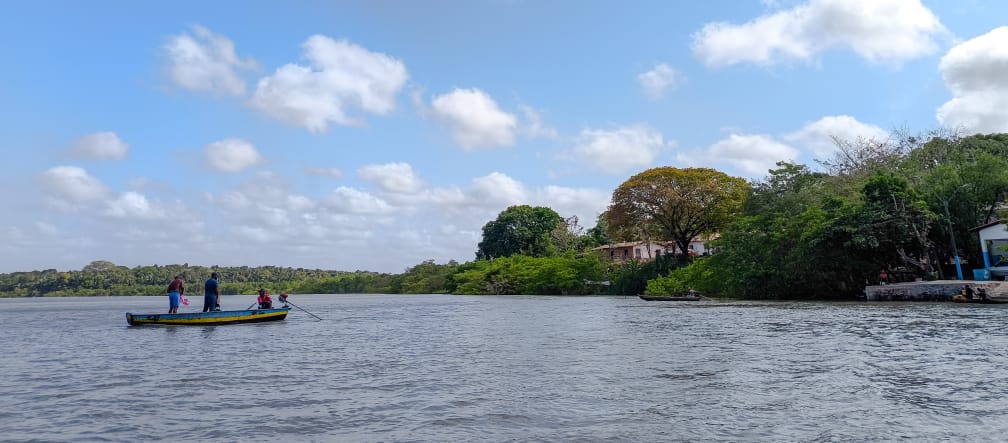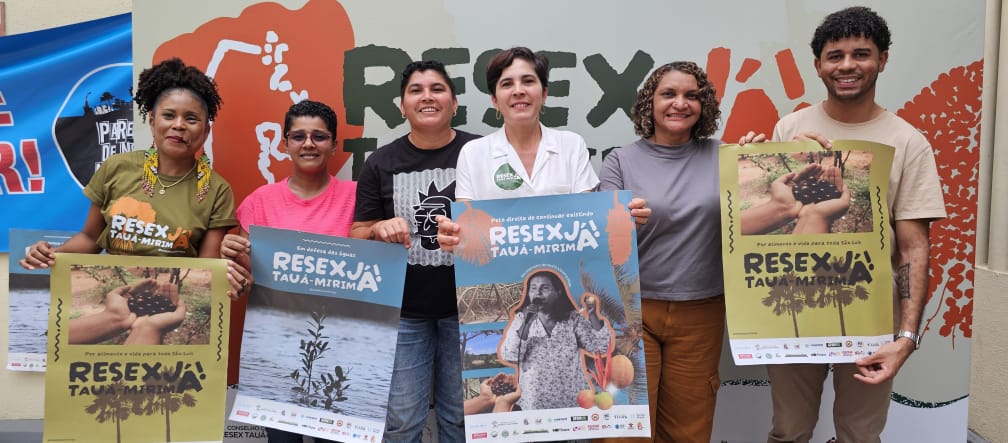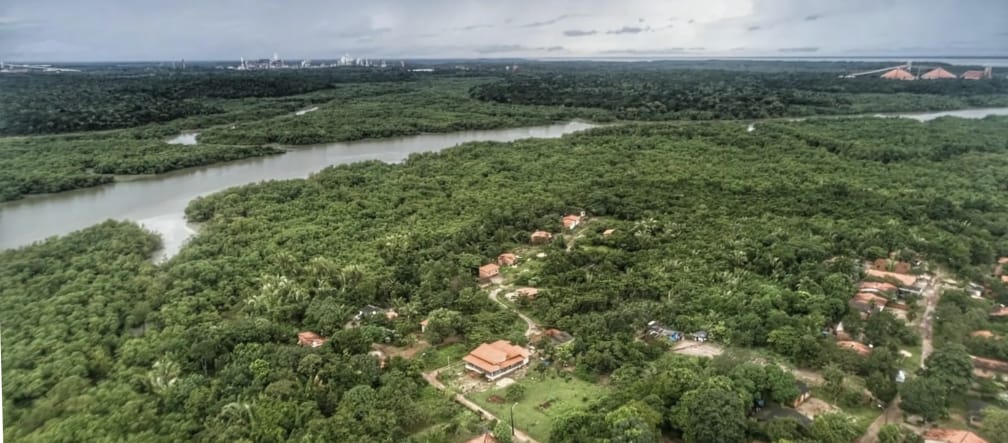Brazil: Protect the mangroves and tropical forests of Tauá-Mirim!
The people of the Tauá-Mirim region in the Amazon are urgently calling on the Brazilian government to protect their land. The rivers, mangroves and tropical forests south of São Luís in the state of Maranhão are threatened by infrastructure, industrial, and agricultural projects. Please support our petition.
To: Luíz Inácio Lula da Silva, President of Brazil; Marina Silva, Minister of Environment and Climate; Mauro Oliveira Pires, President of the Chico Mendes Institute for Biodiversity Conservation; Ricardo Lewandowski, Minister of Justice and Security
“The Brazilian government must act to protect the Tauá-Mirim region in the Brazilian Amazon rainforest.”The Tauá-Mirim area, which covers more than 16,000 hectares, is located on the Gulf of São Marcos, 20 kilometers south of São Luís, the capital of the Brazilian state of Maranhão. The region is home to approximately 2,200 families in twelve communities whose livelihoods depend on fishing, shellfish harvesting, and small-scale farming.
Through their traditional practices, which are closely connected to nature, these communities have preserved the remarkable biological diversity of the coastal and river areas, including mangroves, tropical forests, and many other ecosystems.
Mangroves provide habitat and breeding grounds for numerous animal species, including water birds such as the magnificent scarlet ibis, as well as fish and crustaceans. They also sequester carbon and other greenhouse gases, making them vital for climate protection.
However, both the environment and local livelihoods are threatened by large-scale projects aimed at exporting raw materials, including the planned construction of ports, roads, freight railways, and industrial zones for activities such as aluminum processing.
Since 2003, the communities have advocated for the Brazilian government to designate Tauá-Mirim as a Reserva Extrativista (RESEX).
This type of protected area in Brazil combines nature conservation with the rights and traditional uses of local communities. In the European Union, this would be similar to a biosphere reserve and at international level to a “protected area with sustainable use of natural resources”.
While the Brazilian government delays the recognition of Tauá-Mirim as a protected area, industrial development continues, destroying and polluting the environment and causing illness.
Please support the petition to immediately protect both people and nature by creating the RESEX Tauá-Mirim!
Start of petition: 09/05/2025
Further information in Portuguese:
- Resex Tauá-Mirim Já! on Instagram
https://www.instagram.com/resextauamirimja/
- "Abacaxi judicial deixa pessoas e 17 mil ha de Amazônia desprotegidos no Maranhão": https://oeco.org.br/reportagens/abacaxi-judicial-deixa-pessoas-e-17-mil-ha-de-amazonia-desprotegidos-no-maranhao/
To: Luíz Inácio Lula da Silva, President of Brazil; Marina Silva, Minister of Environment and Climate; Mauro Oliveira Pires, President of the Chico Mendes Institute for Biodiversity Conservation; Ricardo Lewandowski, Minister of Justice and Security
Ladies and Gentlemen,
We, the undersigned, support the people living in the Tauá-Mirim region who, together with other traditional peoples and communities, civil society organizations, social movements and research institutions, call on the Brazilian government to designate TAUÁ-MIRIM as a protected area in the form of a Reserva Extrativista (RESEX).
Tauá-Mirim is located in the Amazon region and belongs administratively to São Luís, the capital of the state of Maranhão. It covers 16,664 hectares and has a coastline of 71 kilometers.
Twelve rural communities are part of Tauá-Mirim: Taim, Rio dos Cachorros, Limoeiro, Porto Grande, part of Cajueiro (Parnauaçu Beach), part of Vila Maranhão (Porto das Arraias), Portinho, Jacamim, Amapá, Embaubau, Ilha Pequena, and Tauá-Mirim.
Approximately 2,200 families in Tauá-Mirim depend mainly on traditional fishing and small-scale farming. The communities have advocated for the establishment of the RESEX since 2003. In 2007, the foundation process was initiated and the socio-ecological studies and the minutes of the public hearings were submitted to the Ministry of the Environment.
Since then, the official establishment of the RESEX by the Brazilian government has not progressed. On May 17, 2015, the communities in Tauá-Mirim decided, through a public assembly, to declare the RESEX themselves. They established a board of directors composed of representatives from the aforementioned and neighboring communities, as well as various support organizations. The council meets regularly, and protective measures have been in place since 2015.
Tauá-Mirim contains fragile ecosystems and unique landscapes, including mangroves, swamps, dunes and palm forests (Euterpe oleracea: açai palm, Mauritia flexuosa: moriche palm, Attalea speciosa: babassu palm). The surrounding areas have already been degraded and even destroyed by the urban expansion of São Luís, including transportation and energy infrastructure and industrial zones.
The region is home to numerous endangered animal species. These include the Caribbean manatee (Trichechus manatus), the hawksbill turtle (Eretmochelys imbricata), the leatherback turtle (Dermochelys coriacea), the goliath grouper (Epinephelus itajara), the blue shark (Prionace glauca), the daggernose shark (Carcharhinus oxyrhynchus) and the margay (Leopardus wiedii).
For centuries, local populations have relied on these ecosystems for their livelihoods. The mangroves are home to the communities' most important sources of protein, food and income; 80% of families in and around the RESEX engage in small-scale fishing for various species of fish, shrimp and crabs.
The ecosystems are not only vital for the people of Tauá-Mirim, but also the population of São Luís, a city of millions, benefits from them. It can be said that the RESEX Tauá-Mirim and its surrounding areas are as important for São Luís as the Amazon region is for Brazil: it is one of the last remaining areas that provides important environmental services for the entire city.
Recognizing this ecological and cultural wealth justifies the creation of a special protection area in the form of a Reserva Extrativista. Law No. 9.985 of July 18, 2000 of the National System of Natural Protected Areas (SNUC) stipulates that the population that lives from and with these areas must be involved in their management and use.
Furthermore, Decree No. 6.040 of February 7, 2007 also aims to guarantee traditional peoples and communities their territories and access to natural resources. They can continue to use them traditionally in order to preserve their way of life, culture and economy.
We therefore demand the formal and legal establishment and effective authorization of Tauá-Mirim as a Reserva Extrativista, as a valid and appropriate means to achieve these goals.
Yours faithfully,
Definition: What is aluminum?
Aluminum is the third most abundant chemical element (symbol AL) and the most abundant metal in the Earth’s crust, where it occurs in the form of oxides and aluminum silicates. The metal aluminum is refined from bauxite. The main producing countries and their respective shares of world production are Australia (29%), China (19%), Guinea (18%), Brazil (10%), India (7%), Jamaica (3%) and Indonesia (3%) (GIZ - BGR 4-2021). In Europe, Greece is the only country with significant bauxite deposits.
The silvery-white metal is particularly light and highly malleable. Aluminum alloys are very strong. The metal reacts with air and water to form a thin oxide layer that protects it from further corrosion.
What is aluminum used for?
In Germany, for example, the automotive industry is the largest consumer, accounting for 47% of the aluminum used in 2019. Other uses of aluminum include construction (14%) and packaging (12%). Electrical engineering and mechanical engineering follow with 7% each, the iron and steel industry with 5%, while the use in household goods, office equipment, furniture and leisure products accounts for 8% (source: German Federal Institute for Geosciences and Natural Resources (BGR), Nov. 2020: Deutschland ‒ Rohstoffsituation 2019).
Conventional cars manufactured in Europe contain an average of 180 kg of the light metal. Much more aluminum is used for SUVs and luxury cars – especially by Jaguar, Land Rover and Porsche – as well as in electric vehicles. The Audi E-Tron contains no less than 800 kg of aluminum (source: European Aluminium 2019: Aluminum Content in European Passenger Cars).
Many disposable products such as coffee pods, soda cans and yogurt lids are made from aluminum. Aluminum salts are also used in antiperspirants and medicines and to regulate the consistency of creams.
Demand for aluminum has skyrocketed in recent years, with devastating consequences.
What is the environmental impact of aluminum?
Although aluminum is the most abundant metal in the Earth’s crust, it is only found in a bonded form. Mining, processing and refining bauxite into raw aluminum is energy-intensive and has a significant environmental impact. Recycling aluminum, on the other hand, uses only 5% of the energy required to extract raw aluminum from ore.
- Rainforest destruction for bauxite mining
Much of the world’s bauxite is found in the tropics. In Australia, Indonesia, Brazil and Guinea, large areas of forest are cleared and soil removed to access the thin layer of rock below the Earth’s surface. In Porto Trombetas, Brazil, an area the size of 250 soccer fields is cleared each year for bauxite mining. - Toxic waste
Aluminum is extracted from bauxite through a complex chemical process. The production of one ton of raw aluminum produces up to four tons of toxic waste, which has a distinctive red color due to the iron-rich compounds it contains. This so-called red mud is stored in huge, open tailings ponds. Leaks and dam breaks are common, often burying entire villages under the highly corrosive sludge. Toxic heavy metals such as lead, cadmium and mercury turn living rivers into toxic dead zones. Even without major accidents, environmental toxins are released into the air, soil and water: People living near mines and aluminum plants complain of contaminated drinking water, skin diseases, and fish die-offs. - High energy consumption in refining
It takes 15 MWh of electricity to produce one ton of aluminum – enough to power a two-person household for five years. Because of its energy-intensive nature, aluminum production is only economically viable if a lot of very cheap electricity is available. To this end, huge hydroelectric dams have been built in Brazil and elsewhere, flooding the rainforest and the land of Indigenous communities.
The negative effects of aluminum are not only felt in the producing countries. Aluminum in everyday products is a health hazard: Salts released from aluminum foil, as well as the aluminum components in deodorants and medicines, can accumulate in our bodies and are suspected of causing cancer and Alzheimer’s disease.
And what can we do about it?
Aluminum is everywhere in our daily lives. Between 2009 and 2016, production increased by nearly 60% to 58.3 million metric tons per year – not least for everyday products. And this is where there is great potential savings.
- Think twice about packaging: Takeout meals in aluminum trays, granola bars in multilayer wrappers – snacks are often packaged in aluminum. It just takes a little planning to prepare snacks at home for school or the office. You can dramatically reduce packaging waste by using sandwich boxes instead of aluminum foil and reusable bottles for beverages (such as home-made iced tea) instead of soda cans.
- Avoid coffee pod waste: One kilogram of coffee in pods can cost up to EUR 80 (USD 95 or GBP 70), making it hard on your wallet and the environment. It takes up to three grams of packaging to deliver six to seven grams of coffee. French presses and stainless steel stovetop espresso makers are economical and environmentally friendly alternatives.
- Get the most life out of aluminum products: Aluminum can be found in many household items such as computer cases, aluminum shelving and carpet strips. Investing in high-quality products and using them as long as possible can reduce your aluminum footprint.
- Recycle aluminum: It’s not always possible to avoid aluminum packaging altogether. However, the raw materials in such packaging can theoretically be reused indefinitely – as long as we dispose of it with care to ensure it is recycled.
- Hit the road without hundreds of kilos of aluminum: The up to 150 kilograms of aluminum in a new car is a pretty good argument for biking or taking public transportation.
- Avoid aluminum for your health: Aluminum-free natural cosmetics and deodorants without aluminum salts (e.g. soda-based) are a healthy choice. Pharmacists can often recommend alternatives to medications containing aluminum such as antacids. Do not store acidic foods in aluminum foil: harmful aluminum salts can leach into the food.
- Share and spread the word: Very few people are aware of the link between coffee pods and rainforest destruction. Please share this information widely to raise awareness of the dangers of aluminum. If demand for aluminum products drops, companies can be persuaded to change their ways. Online petitions are also a powerful tool for change.
Taim, Rio dos Cachorros, Limoeiro, Porto Grande, Cajueiro, Vila Maranhão, Portinho, Jacamim, Amapá, Embaubal, Ilha Pequena and Tauá-Mirim
According to the guidelines of the International Union for Conservation of Nature (IUCN). See Dudley, N., 2008. Guidelines for Applying Protected Area Management Categories: https://portals.iucn.org/library/sites/library/files/documents/pag-021.pdf


